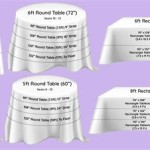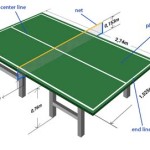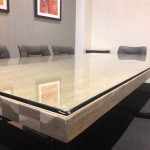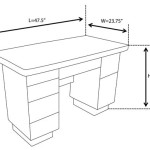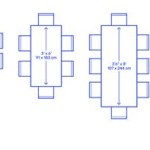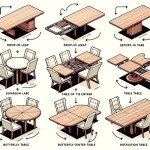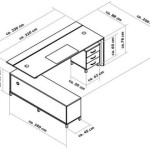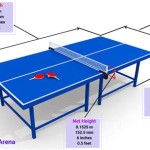Folding Dining Tables: Efficient Solutions for Small Space Living
In contemporary urban environments, maximizing space is often a paramount concern for residents. Compact apartments and smaller homes necessitate innovative furniture solutions that provide functionality without sacrificing precious square footage. Folding dining tables have emerged as a popular and practical choice, offering a versatile option for those who require a dining surface only when needed and desire to reclaim space afterward. These tables are designed to be easily collapsed and stored, making them ideal for small apartments, studios, and even multi-functional rooms where the dining area might need to be transformed into a living space or workspace.
The fundamental principle behind folding dining tables lies in their adaptability. They offer a tangible benefit to individuals living in areas where space is at a premium, providing a dining surface for meals and gatherings without permanently occupying a large area. This adaptability extends beyond mere size; folding tables are available in a variety of styles, materials, and designs, catering to diverse aesthetic preferences and functional requirements. Whether one seeks a minimalist, modern aesthetic or a more rustic, traditional look, a folding dining table can be found to complement the existing décor.
However, the selection of an appropriate folding dining table requires careful consideration. Several factors, including the size of the available space, the number of people typically accommodated, the desired style, and the quality of the materials, must be evaluated. A well-chosen folding dining table can significantly enhance the functionality and aesthetic appeal of a small living space, while a poorly chosen one can impede movement and create a cluttered environment.
Key Benefits of Folding Dining Tables
The primary advantage of a folding dining table lies in its space-saving capabilities. When not in use, the table can be folded and stored, freeing up floor space for other activities. This feature is particularly valuable in small apartments or studios, where every square foot counts. The freed-up space can be used for other furniture, exercise, a home office, or simply to create a more open and airy feel.
Beyond space saving, folding dining tables offer considerable versatility. They can be easily adapted to accommodate varying numbers of diners. Many models incorporate drop-leaf designs or extension mechanisms that allow the table to be expanded when needed and reduced in size when not in use. This flexibility makes them suitable for both everyday meals and occasional gatherings with friends and family. A single individual can dine comfortably using a smaller configuration, while a larger group can be accommodated by extending the table to its full size.
A further benefit relates to portability. Folding tables are generally lighter and easier to move than traditional dining tables. This portability allows for greater flexibility in the use of the table. It can be easily moved from one room to another, or even taken outdoors for picnics or barbecues. This can be especially beneficial for small spaces that serve many functions. Some have wheels or casters to facilitate easier mobility.
Types of Folding Dining Tables
Folding dining tables come in a variety of designs, each with its own unique features and benefits. Understanding the different types available is crucial for selecting the right table for specific needs and preferences. Drop-leaf tables, gateleg tables, and wall-mounted tables are among the most common options.
Drop-leaf tables feature hinged leaves that can be folded down to reduce the table's size. When extra surface area is needed, the leaves can be raised and supported by brackets or legs. The drop-leaf design is versatile, allowing the table to be used in different configurations to suit varying needs. When both leaves are dropped, the table can be significantly reduced in size, making it ideal for small spaces. These are often supported by legs on either end. When the leaves are lifted, they are then supported by brackets that swing out from underneath the table.
Gateleg tables have hinged legs that swing out to support the leaves. When the leaves are folded down, the legs fold inward, allowing the table to be stored compactly. Gateleg tables are typically more substantial than drop-leaf tables, offering greater stability and durability. Their design often provides a more traditional aesthetic. This extra stability is what many people are looking for when investing in a dining room table. Many gateleg tables have storage drawers attached to them as well.
Wall-mounted folding tables are attached to the wall and can be folded down when not in use. These tables are particularly space-saving, as they do not require any floor space when folded. Wall-mounted tables are ideal for very small apartments or studios where every inch of space is valuable. Some models are designed to function as desks or workstations when folded down, adding to their versatility. They must be attached to the wall using suitable hardware, ensuring they are securely mounted and can support the intended weight.
Factors to Consider When Choosing a Folding Dining Table
Selecting the right folding dining table requires careful consideration of several factors. These include the size of the space, the number of people to be accommodated, the style of the table, the materials used, and the ease of operation. A thorough assessment of these factors will help ensure that the chosen table is both functional and aesthetically pleasing.
The available space is a primary consideration. Measure the area where the table will be used, both when extended and when folded. Ensure that there is enough clearance for chairs around the table when it is extended and that the folded table does not obstruct walkways or doorways. Consider the overall layout of the room and how the table will fit within it.
The number of people who will typically use the table is another important factor. Choose a table that is large enough to comfortably accommodate the usual number of diners. If the table will be used for occasional gatherings, consider a model with extension capabilities to accommodate larger groups. Think realistically about how often the table will be used for different numbers of people.
The style of the table should complement the existing décor of the room. Folding dining tables are available in a wide range of styles, from modern and minimalist to traditional and rustic. Choose a style that matches the overall aesthetic of the space. Consider the color, finish, and design of the table to ensure that it blends seamlessly with the other furniture and accessories in the room.
The materials used in the construction of the table will affect its durability, stability, and appearance. Common materials include wood, metal, and laminate. Wood tables offer a classic and timeless look but may require more maintenance. Metal tables are durable and easy to clean, but may have a more industrial aesthetic. Laminate tables are affordable and resistant to scratches and stains, but may not be as durable as wood or metal. The materials chosen should be appropriate for the intended use and the overall style of the room.
Finally, consider the ease of operation of the folding mechanism. The table should be easy to fold and unfold, without requiring excessive effort or specialized tools. Check the stability of the table when it is extended and ensure that the folding mechanism is secure and reliable. Read reviews and consider trying out the table in person before making a purchase, if possible, to assess its ease of use.
The functionality of folding dining tables extends beyond their space-saving design. Many models offer additional features that enhance their practicality. Some tables include built-in storage shelves or drawers, providing a convenient place to store placemats, napkins, or other dining essentials. Others feature adjustable height settings, allowing the table to be used as a desk or workstation. These added features can significantly increase the versatility of the table and make it an even more valuable addition to a small living space.
In addition to these practical considerations, the environmental impact of the table should also be taken into account. Choose a table made from sustainable materials, such as reclaimed wood or bamboo. Look for manufacturers who use environmentally friendly production methods. By making conscious choices about the materials and manufacturing processes, consumers can reduce their environmental footprint and support sustainable practices.
The care and maintenance of a folding dining table will depend on the materials used in its construction. Wood tables should be cleaned with a soft cloth and a wood-friendly cleaner. Metal tables can be cleaned with a damp cloth and a mild detergent. Laminate tables are generally easy to clean and maintain. Regardless of the material, it is important to protect the table from scratches and stains by using placemats and coasters. Regular cleaning and maintenance will help to keep the table looking its best and extend its lifespan.

Choose A Folding Dining Table For Your Small Space Chairs Spaces Expandable

Multifunctional Folding Table Dining For Small Spaces With 2 Tier Shelves Diy At B Q

Space Saving Transforming Tables Expand Furniture

Solid Wood Folding Multifunctional Dining Table For Small Apartments Sps Furntiure

Folding Dining Table With Storage Space Multifunction For Kitchen Bedroom Living Room Beige Com

Choose A Folding Dining Table For Your Small Space Adorable Home Collapsible Kitchen Saving

Homefan Folding Dining Table Drop Leaf Kitchen For Small Spaces With 2 Tier Storage Racks Multifunctional Space Saving Extension Dinner White Com

41 Extendable Dining Tables To Maximize Your Space

12 Brilliant Dining Table Ideas For Your Small Space Living In A Shoebox

Folding Dining Table W 6 Wheels Drop Leaf Tables For Small Spaces Kitchen

